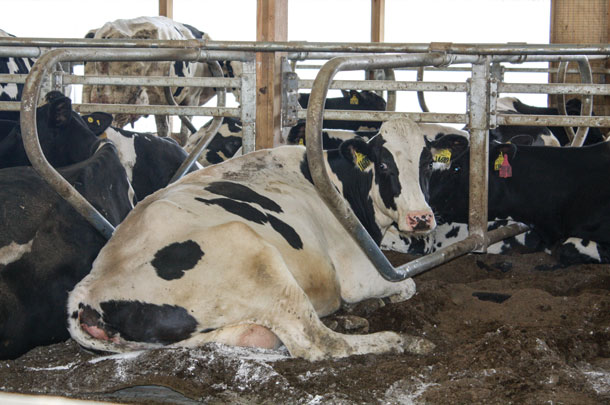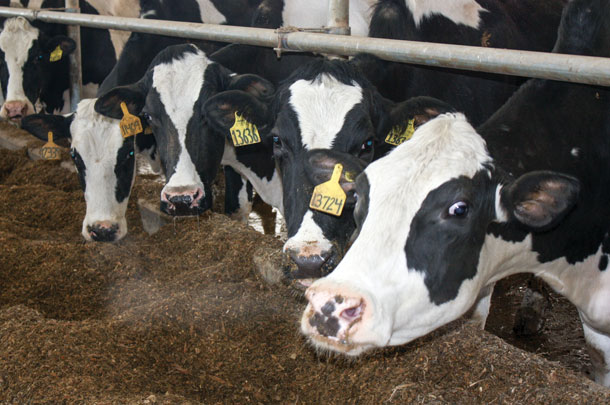Building a new barn without adding cows could be a tough sell to a lender, but for Oakwood Dairy in Auburn, New York, the investment in top-notch cow facilities is proving to be well worth the cost.
Progressive growth
Progressiveness has been the theme at Oakwood Dairy for three generations. The dairy Kelly O’Hara’s grandparents started with two cows in the 1940s has grown incrementally to the present size of 2,000 milking cows and 1,800 head of youngstock.
His father, Ted, built a milking parlor in the 1970s, increased the herd from 100 cows to 350 cows and added new facilities in 1993 to accommodate 500 cows. They continued to grow from there.
“We built another barn, adding more cows every couple of years until about 10 years ago,” O’Hara says. “Then we shifted the focus to upgrading older facilities for youngstock and increasing cow comfort.”
For the last decade, O’Hara’s attention has been on maximizing the use of existing buildings on the site. The original milking facility was converted into a freshening center, and the adjoining barn now includes a bedded pack for calving. He added on to the main lactating cow barns and continually looks for ways to increase comfort, such as moving out the walls of the six-row barn built in the ’90s to increase lunge space.
Adding stalls, not cows
Making a continual effort to keep on the cutting edge of cow comfort, O’Hara constructed another six-row freestall barn two years ago that added 450 stalls. With the parlor at capacity, increasing cow numbers was not the priority; his goals were to reduce overcrowding, increase lying time and bunk space, and grasp a few more pounds of milk per cow.
“We reduced overcrowding from 21 to 22 percent down to 5 percent,” he says.
The two high-producing groups housed in this 120-feet-wide-by-500-feet-long barn are thriving with reduced competition for stalls and feed, and wide crossovers to provide interruption-free access to the ample water supply.
Rebounding from rBST
O’Hara believes providing more stalls, more room at the feedbunk and a comfort-controlled environment contributed to a rebound in milk production after the dairy ceased rBST use. Milk per cow initially dropped from 91 pounds to 85 pounds per day; however, within six to eight months, production returned to that level and has since exceeded it.
“We couldn’t relate it to feed or weather, so we felt it must be the facilities,” he says. “Now, with 2016 feeds, we are around 95 pounds, or 97 pounds of energy-corrected milk.”
The best of both worlds
O’Hara incorporated design concepts into this barn that pleased cows and also fit with the dairy’s current management practices, like using composted manure solids for bedding in the waterbed-based stalls.
The dairy has been drying their own manure since 1993, perfecting the technique to achieve 38 percent dry matter by the time it reaches the stalls. The process includes two screw presses to remove water and a composting drum that heats the solids to 140ºF for an effective pathogen kill.

Over the years, O’Hara experimented with deep beds but found it difficult to keep the pathogen level at bay as the material heated. He also tried sand but found it cost-prohibitive and not a good fit for his long-term vision of setting up the farm for a future anaerobic digester.
He finds greatest success bedding stalls three times per week with the composted manure followed by a half-pound of hydrated lime sprinkled in the back for a drying effect.
“We are most concerned with bedding quality,” O’Hara states. “We want clean cows and clean udders to assure quality premiums.” The dairy has achieved that, with the somatic cell count running consistently at or below 130,000.
In control of comfort
Cows find comfort in the newest barn at Oakwood Dairy, which combines the best aspects from their previous barns interfused with technological advancements in ventilation and lighting.
Ventilation was high on O’Hara’s priority list in designing this facility. He had experimented with tunnel ventilation in the past but ran into challenges. “As we built on and buildings got longer, we couldn’t pull enough air from the air exchange,” he explained.
That is why he chose a natural ventilation system for this barn that uses 54 mixing fans to cool cows. Above, to act as a moisture barrier, there is a 4-inch layer of cellulose-fiber insulation, protected by a white powder-coated aluminum ceiling that deters birds from nesting. In the “attic” above this ceiling, two 51-inch fans keep temperatures in the barn lower and further reduce moisture.

Oakwood Dairy is experimenting with a prototype for an automated, wireless system with control modules for curtains, fans and soakers throughout the barn that adjust to air speed, humidity, temperature and other climate considerations.
O’Hara sees the benefits of an automatically controlled environment, noting, “The temperature sensor doesn’t have an opinion. To get consistency, you have to take the human factor out of it.”
During periods of heat and humidity, soakers kick in over the feedbunk and in the holding area. It took a little fine-tuning to perfect water volume and timing, O’Hara says. At first, they were seeing a spike in cell count during the summer – but quickly determined it was caused by heavy soaking in the holding area that ran down the cows’ sides to the udder and the top of the milking inflations. Shortening soaking intervals resolved this challenge.
The barn’s LED lights are also set on a timer. While his other barns have these energy-efficient lights over each row of cows, this barn features a third row over the center of the feed alley to better distribute light throughout the building. This reduces foot candles in the outside areas of the barn while still providing enough light for employees working at night to see.
Looking ahead
As O’Hara looks ahead to the future of his dairy, he is assured the depth and detail that went into designing his facility not only positioned cows for optimized performance but also for any forthcoming animal well-being initiatives and regulations. “I feel confident this barn is the closest we could come to meeting whatever expectations could be thrown at us,” he says.
For O’Hara, the two concepts just go hand-in-hand.
“When we maximize cow comfort, it should automatically meet the requirements of those programs. It’s kind of a side benefit of making a healthier environment for the cows,” he adds. “We are trying to design a barn to be more efficient and take better care of our animals.” ![]()
PHOTO 1: Two years ago, Oakwood Dairy built a 450-stall barn with the goals of relieving overcrowding and increasing lying time and bunk space.
PHOTO 2: Cows rest on dual-chamber waterbeds top-bedded with composted dried manure solids.
PHOTO 3: O’Hara included a feed rail as opposed to lockups in the majority of the newly built barn, believing the quietness contributes to a comfortable, peaceful cow environment. Photos by Peggy Coffeen.

-
Peggy Coffeen
- Editor
- Progressive Dairyman
- Email Peggy Coffeen







